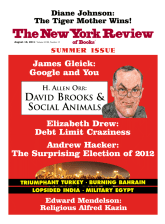In response to:
'What Andy Warhol Did': An Exchange from the June 9, 2011 issue
The Warhol Foundation on Trial from the February 25, 2010 issue
What Is a Warhol?: An Exchange from the December 17, 2009 issue
'What Is an Andy Warhol?': An Exchange from the November 19, 2009 issue
To the Editors:
The many scholarly exchanges in The New York Review on Andy Warhol’s disputed red silk-screen self-portraits [November 19, 2009, December 17, 2009, February 25, 2010, June 9, 2011] make for good reading. I thought the last one between Reva Wolf and Richard Dorment was brilliant (on his part). Since my name comes up frequently in these pieces, I’d like to provide the one thing that seems to be missing: the context in which these controversial silk-screen portraits were made.
This edition of Warhol’s silk-screen portraits was made from acetate separations provided by Warhol for display in conjunction with the 1965 world premiere of video art made by Warhol and his associate Paul Morrisey. In the words of Michael Rush, author of Video Art (Thames and Hudson, second edition, 2007), this was “a seminal moment in art history.” That’s because this was the first public showing of video art made by a noted artist. In my opinion, Warhol should be considered the “father” of video art.
Warhol and I met when I was publishing Tape Recording magazine. He and noted art authority Henry Geldzahler agreed to serve as judges for a “Pop Sounds” contest sponsored by Tape Recording. Afterward, Andy, a tape recording enthusiast, would call me regularly to secure tape equipment and blank tapes at no cost. When Norelco introduced the first video recorder for consumer use, Andy asked me to get him a recorder from Norelco, along with cameras and tapes so that he and Morrisey could produce so-called “underground” videos.
I agreed to sponsor the world premiere of these videos in an underground location. The party was held on an unused rail platform underneath the Waldorf Astoria Hotel in New York City, adjacent to the tracks of the New York Central Railroad. Guests had to enter through a fire door on East 49th Street and descend two long staircases to reach the tracks, which then had to be crossed to reach the platform. The Waldorf Astoria Hotel was kind enough to run an electric line down to the platform so we could show the work. We had to move in by hand the bulky equipment needed to project the sound and video. We weren’t able to serve food at the party because there were rats around.
The New York Herald Tribune had a photographer on hand to document everything—including a staged “happening” in which two costumed Elizabethan swordsmen suddenly began dueling on the platform. The story with photos appeared in the Sunday edition of the Herald Tribune. The red Warhol self-portrait was on display for all to see. And a new chapter of art history was written in the bowels of Manhattan.
Richard Ekstract
New York City
Richard Dorment replies:
The party in the tunnels under the Waldorf Astoria that Richard Ekstract describes so vividly celebrated the premiere of Warhol’s first video with Edie Sedgwick, Outer and Inner Space, a work that J. Hoberman memorably described in The New York Times as “a masterpiece of video art made before the term even existed.” For the history of art, however, the Red Self Portraits exhibited at the same party are just as significant. Created at a moment when Warhol was particularly close to Marcel Duchamp, this is the first time Warhol used the “hands-off” working method that would become routine in the 1970s and 1980s and that set a precedent for the highly visual approach to making conceptual art that characterizes the work of so many major artists who emerged after Warhol’s death, including Jeff Koons and Takashi Murakami. Mr. Ekstract’s letter is for the history books. Its publication gives me a chance to write about how the Red Self Portraits series came to be made. Because this is of special interest to readers who have been following the controversy in The New York Review of Books, it is published online at nybooks.test/u/8.
This Issue
August 18, 2011
What Were They Thinking?
Fooled by Science
How Google Dominates Us



